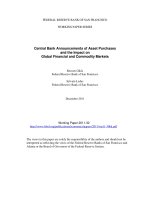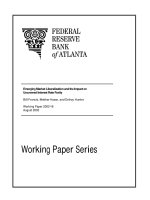Financial accounting the impact on decision makers 9e chapter 9
Bạn đang xem bản rút gọn của tài liệu. Xem và tải ngay bản đầy đủ của tài liệu tại đây (3.18 MB, 43 trang )
Chapter 9
Current Liabilities, Contingencies,
and the Time Value of Money
Current Liabilities
Obligation that will be satisfied within one year or within
current operating cycle
Normally recorded at face value and are important
because they are indications of a company’s liquidity
Examples:
Accounts payable
Notes payable
Current portion of long-term debt
Taxes payable
Other accrued liabilities
LO 1
Accounts Payable
Amounts owed for inventory, goods, or services acquired in the normal
course of business
Usually do not require the payment of interest, but terms may be
given to encourage early payment
Example: 2/10, n/30
A
2% discount is available if payment occurs within
the first ten days
If payment is not made within ten days, the full
amount must be paid within 30 days
Notes Payable
Amounts owed that are represented by a formal contract
Formal agreement is signed by the parties to the
transaction
Arise from dealing with a supplier or acquiring a cash loan from a bank
or creditor
The accounting for notes depends on whether the interest is paid on
the note’s due date or is deducted before the borrower receives the
loan proceeds
Example 9.1—Recording the Interest on
Notes Payable
Assume that Hot Coffee Inc. receives a one-year loan from First
National Bank on January 1. The face amount of the note of
$1,000 must be repaid on December 31 along with interest at
the rate of 12%
Example 9.1—Recording the Interest on
Notes Payable (continued)
The company could identify and analyze the effect of the repayment as
follows:
Example 9.2—Discounting a Note
Suppose that on January 1, 2014, First National Bank granted to Hot
Coffee a $1,000 loan, due on December 31, 2014, but deducted the
interest in advance and gave Hot Coffee the remaining amount of $880
($1,000 face amount of the note less interest of $120)
Example 9.2—Discounting a Note
(continued)
The Discount on Notes Payable account should be treated as a
reduction of Notes Payable. If a balance sheet was developed
immediately after the January 1 loan, the note would appear in the
Current Liability category as follows:
Example 9.2—Discounting a Note
(continued)
The original balance in the Discount on Notes Payable account
represents interest that must be transferred to interest expense over
the life of the note. Refer to Example 9-2. Before Hot Coffee presents
its year-end financial statements, it must make an adjustment to
transfer the discount to interest expense
Example 9.2—Discounting a Note
(continued)
Thus, the balance of the Discount on Notes Payable account is zero
and $120 has been transferred to interest expense. When the note is
repaid on December 31, 2014, Hot Coffee must repay the full amount
of the note
Recording Current Maturities of LongTerm Debt
The portion of a long-term liability that will be paid within one year
Example 9.3—Recording Current
Maturities of Long-Term Debt
Assume that on January 1, 2014, your firm obtained a $10,000
loan from the bank. The terms of the loan require you to make
payments in the amount of $1,000 per year for ten years
payable each January 1 beginning January 1, 2015. On
December 31, 2014, an entry should be made to classify a
portion of the balance as a current liability
Recording Current Maturities of LongTerm Debt
Refer to the information in Example 9-3. On January 1, 2015, the
company must pay $1,000
Current Liabilities—Accruals
Taxes Payable: business make an accounting entry, usually as
one of the year-end adjusting entries, to record the
amount of tax that has been incurred but is unpaid
LO 2
Current Liabilities—Other Accrued
Liabilities
Include any amount that has been incurred but has not yet been paid
Example 9.4—Recording Accrued
Liabilities
Suppose that your firm has a payroll of $1,000 per day Monday
through Friday and that employees are paid at the close of work
each Friday. Also, suppose that December 31 is the end of your
accounting year and that it falls on a Tuesday
Recording Accrued Liabilities
Assume that you received a one-year loan of $10,000 on
December 1. The loan carries a 12% interest rate. On December
31, an accounting entry must be made to record interest even
though the money may not actually be due.
IFRS and Current Liabilities
International accounting standards require companies to present
classified balance sheets with liabilities classified as either current or
long term
U.S. standards do not require a classified balance sheet
Exhibit 9.2—Current Liabilities on the
Statement of Cash Flows
LO 3
Exhibit 9.3—Starbucks Corporation Partial Consolidated
Statement of Cash Flows (In millions)
Contingent Liabilities
Existing condition for which the outcome is not
known but depends on some future event
Recorded if the liability is probable and the amount
can be reasonably estimated
Accrued and reflected on the balance sheet if it is
probable and if the amount can be reasonably
estimated
Examples:
Premiums or coupons
Lawsuits and legal claims
Warranties and guarantees
LO 4
Example 9.5—Recording a Liability for
Warranties
Assume that Quickkey Computer sells a computer product for
$5,000 with a one-year warranty in case the product must be
repaired. Assume that in 2014, Quickkey sold 100 computers for
a total sales revenue of $500,000 Using an analysis of past
warranty records, Quickkey estimates that repairs will average
2% of total sales
Exhibit 9.4—Note Disclosure of
Contingencies for Burger King Corporation
Contingent Liabilities versus
Contingent Assets
IFRS and Contingencies
International standards
– Not recorded in the
balance sheet—only
provision is recorded
– Probable means—‘‘more
likely than not’’ to occur
– Require the amount
recorded as a liability to
be ‘‘discounted’’ or
recorded as a present
value amount
U.S. standards
– Recorded in the balance
sheet if it is probable
and can be reasonably
estimated
– Has a higher threshold
than this
– Do not have a similar
requirement









